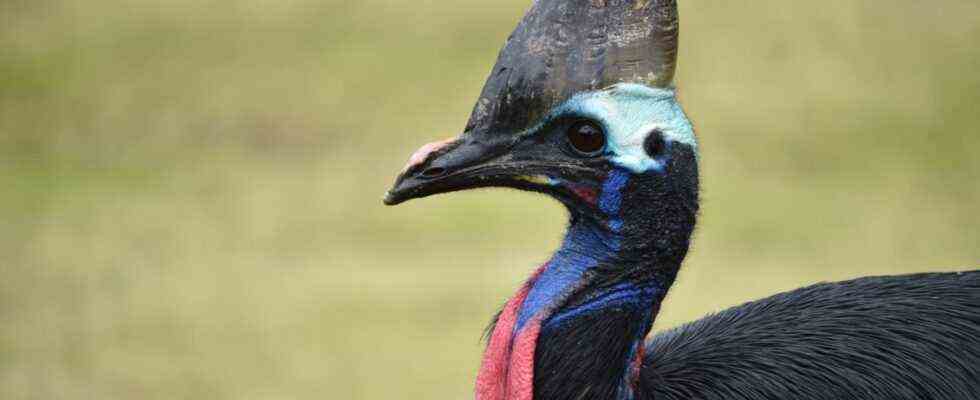Many claim that life is not easy. One for which this is probably true is the cassowary. The mighty bird weighs around 70 kilos, cannot fly, but can run very quickly and lives in the forests of New Guinea and parts of Australia. That in itself is not yet a difficult fate. But as soon as the cassowary has hatched from its egg, it has to live with the attribute of being the “most dangerous bird in the world”. Indeed, its sharp claws are a powerful weapon that can kill a person. In 2019, the owner of a captive cassowary in Florida who tried to take an egg from his bird to sell was killed. Such attacks are very rare, but the bird has lost its reputation as a “modern velociraptor” or “killer bird”.
Obviously, that wasn’t always the case. A long, surprisingly long time ago, the people of what is now New Guinea discovered the virtues of the large bird – especially its tasty meat. To get at this more easily, people apparently took cassowary eggs 18,000 years ago, let them hatch and possibly even raised the chicks up to a certain age. The latter are so far only – depending on the point of view, rather research to plausible – conclusions. But this theory, which a team led by Kristina Douglass from Pennsylvania State University, should be in the journal PNAS describes, prove to be correct, it is probably the oldest approach to the domestication of birds.
For their study, the scientists examined the remains of eggshells from various cassowaries kept in museums. This is not particularly common sample material for archaeological studies – wrongly, as the authors write with some pathos: “The shells of bird eggs are a key material for understanding the evolution of complex human behavior.”
Most likely the thighs and lower legs of the birds were eaten
With the help of three-dimensional laser microscopes, among other things, Douglass and her colleagues were able to determine how far developed each egg had already been. A pattern emerged: especially the somewhat younger samples, between 9,000 and 11,000 years old, came from eggs in which the chicks were already very well developed and were probably about to hatch.
From this knowledge and further analyzes, the researchers derive their theory: Initially, people probably mainly ate the cassowary eggs. But at some point they could have got the idea to let the chicks hatch and grow. After all, there is some good meat even on a half-grown cassowary. “As a flightless bird with extremely reduced wings, the upper and lower legs in particular are likely to have provided most of the meat,” the authors write. However, even they consider it unlikely that cassowaries were kept as farm animals to the extent known from the first human-cared chickens. Nevertheless: chicken and Homo sapiens only found each other about 8000 years ago. At this point in time, according to the current study, humans and cassowaries had already spent several millennia together.
Even if cassowary chicks were raised to provide animal protein, they were still doing better in the long run than many of the other large animals that New Guinea’s first residents had encountered. Settlement of the area began more than 40,000 years ago. Back then, the forests there were far less accessible than they are today, and apart from cassowaries, they were populated by giant kangaroos and pouch wolves. What happened next cannot be exactly reconstructed, but the result is clear: Humans continued to expand, giant kangaroos and thylacines died out over the course of millennia. The same fate befell other large ratites such as the elephant bird in Madagascar and the moa in New Zealand. It is wrong to assume that only people who settled down and worked in agriculture would have profoundly changed the landscape, writes the Douglass team. Even hunter-gatherer communities have already intervened considerably in the ecosystems – with sometimes fatal consequences for many animal species.
Why the cassowary of all things survived is unclear. But this still allows the inhabitants of New Guinea to enjoy the meat of these birds and to adorn themselves with their feathers in religious rituals or to trade with them. The supposedly violent nature of the cassowary does not seem to prevent it from doing so; the chicks are easy to get along with.
However, adult males can be dangerous. In the case of the helmet cassowaries, they take on the brood of eggs and the rearing of the young, which lasts a good one and a half months. Once the clutch has hatched, the father no longer understands the joke. The situation is exacerbated by the pushing back of the rainforest. As a result, humans and cassowaries meet each other more often, although the birds are actually extremely shy. Seen in this way, there is not much murderous left to attach to the cassowary. And a dad who stands protectively in front of his children – isn’t that a little likable too?

